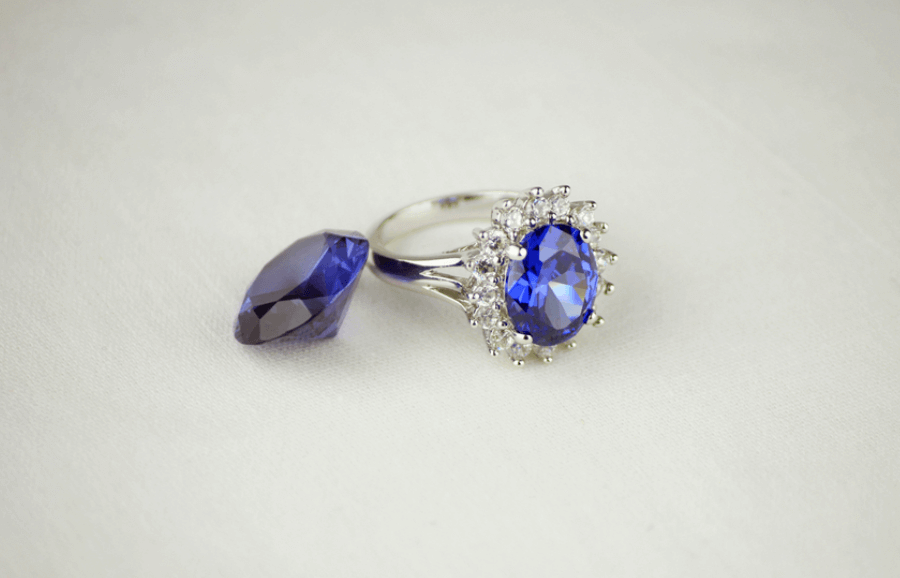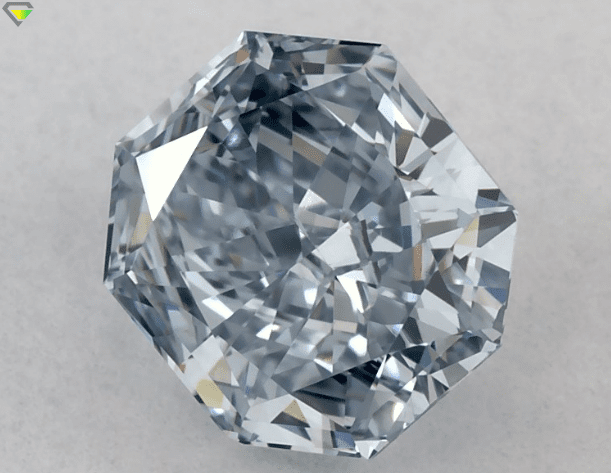
Table of Contents
If colorless diamonds aren’t your thing, you might be considering a blue gemstone. Blue symbolizes trust, loyalty, and honesty – ideal traits for an engagement ring. It’s a color chosen by many royal brides.
There are many blue gemstones used in jewelry, but not all of them are suitable for engagement rings. Is the stone durable enough for daily wear? Is it available? How much does it cost? These, and more, are questions to ask when deciding on the best blue gemstone for you.
Let’s take a look at the best blue gemstones for engagement rings and the gemstones you should avoid.
Best Blue Gemstones for Engagement Rings
There are only two types of blue gemstones that all jewelers will recommend for engagement rings – diamonds and sapphires.
1. Blue Diamond Engagement Rings

Bottom Line: The most prestigious, durable, and valuable blue gemstone. Synthetic versions are a more practical and affordable option.
The best of all blue gemstones, blue diamonds are a stunning choice. Not only is a vivid blue diamond beautiful and eye-catching, but these gemstones are extremely durable, scratch resistant and valuable. On the flip side, most of us can’t afford the huge sums of money that blue diamonds cost, as high quality blue diamonds are among the most expensive stones in the world.
The next best thing is to go for a synthetic blue diamond, like this one, which has all the properties of a mined stone. Notice the beautiful depth and color of the stone which is every bit as good as a mined blue diamond.
Synthetic blue diamonds are still relatively expensive due to the intensive process required to create them. While they are much more affordable than natural blue diamonds, a synthetic blue diamond will still command a high price, especially if it is of high quality.
If your heart is set on a blue diamond, finding a ready-made blue diamond engagement ring can be difficult due to their rarity, meaning that you will most likely have to have yours custom made. Sites like James Allen and Leibish offer a good range of blue diamonds and will work with you to custom create your ring.
2. Blue Sapphire Engagement Rings

Bottom Line: The most prestigious, durable, and valuable blue gemstone. Synthetic versions are a more practical and affordable optio
Sapphires are the most popular blue gemstone for engagement rings, with good reason. They are much more affordable and easier to find than blue diamonds, have excellent durability and can be a great investment option.
Blue sapphires rank at 9 on the Mohs scale of hardness, meaning that they are extremely scratch resistant. What’s more, they’re tough and do not easily break or chip. As such, sapphires are the best gemstone, next to diamonds, for blue engagement rings.
Blue sapphires come in a variety of shades, but opt for a stone with vivid color and with good clarity like the one featured above. Because sapphires pair so well with colorless diamonds, you can select an engagement ring that marries these two stones beautifully.

One good option is to have a halo of little diamonds surrounding the center stone of sapphire. If this is a little too blue for you, you can reverse this, going for a halo of blue sapphires with a center colorless diamond.
Sapphire are easy to clean and requires minimal maintenance. They’re ideal for every day wear and you won’t have to keep taking out your engagement ring to protect it.
As with diamonds, if you don’t want to shell out a large sum of money for a mined stone, you can find yourself a synthetic blue sapphire which is exactly the same as a natural stone in terms of its optical and physical properties.
Blue Gemstones to Wear with Care
The following blue gemstones are frequently chosen for engagement rings and can be worn on a regular basis. But this must be done with care if you want the ring to last. Over time, you may have to replace these gemstones.
1. Aquamarine Engagement Rings

Aquamarine, a gemstone that is also a color, is famed for its sea-blue calming hue. The color of an aquamarine is quite distinct, with hints of sea and sky, making it one of the most popular blue gemstones.
This gemstone is fairly hard (7.5 to 8 Mohs) and does not scratch too easily, but if you opt for an aquamarine engagement ring, it will require extra maintenance.
Even with all this precaution, you may need to re-cut or re-polish the stone every so often, to remove scuff marks and scratches across the gemstones surface.
It’s also a good idea to have the stone set in a protective setting such as bezel or halo, as this will provide an additional buffer from knocks and scratches against other objects. Avoid a solitaire setting as the aquamarine is more susceptible to damage.
2. Blue Topaz Engagement Rings

Topaz in nature is generally colorless, but because the blue variety is so popular, these colorless stones are heat treated to produce the blue variety that is so in demand.
One of the appeals of blue topaz is that it is affordable, durable (Mohs 8) and easily available. But over time, the shine and sparkle of topaz will become cloudy and dull as scratches accumulate and the facets begin to wear down.
3. Tanzanite Engagement Rings

Tanzanite, from Tanzania, is often called one of the most underrated gemstones in history. Its beauty and color can rival that of even the finest sapphires, and it’s rarer than most gemstones out there. What’s more, tanzanite sources continue to deplete at a fast rate and new mines have not been located. All this makes the tanzanite a highly desirable gemstone.
A high quality tanzanite gemstone can cost a hefty sum, but it will still be more affordable than a similar sapphire.
While it is harder than an emerald, tanzanites are much softer than sapphires. They are easily scratched and their sparkle can fade with time. Take care when purchasing tanzanite as there are many fakes on the market.
Blue Gemstones to Avoid in Engagement Rings
While these gemstones are absolutely gorgeous and will make good jewelry in earrings, pendants, bracelets or even rings to be worn infrequently, they are not recommended for daily wear. As gemstones for engagement rings, we recommend that you avoid the following gemstones.
1. Turquoise

Turquoise is beautiful in jewelry but is too soft for daily wear in engagement rings. They are porous and therefore highly susceptible to breakage. They also come heavily included.
2. Blue Pearl
Blue pearls are highly valued for their rarity (if natural) and have an intriguing look to them. However, avoid pearls when it comes to engagement rings, unless you are prepared to have the pearl replaced every so often. Pearls are very easily abraded and the nacre can flake off over time. They are not a good choice for engagement rings, unless set in a highly protective setting.
3. Lapis Lazuli

A beautiful gemstone that has been used for centuries in jewelry, lapis lazuli ranks only 5 to 6 on the Mohs scale. It also easily chips and can break due to the typical inclusions that it is found with. While it’s not a good choice for daily wear, lapis jewelry is simply stunning and very unique and the best part? It is generally very affordable.
4. Blue Tourmaline

Blue tourmaline comes in two varieties – Paraiba and indicolite. While both are valuable and rare, and quite stunning gemstones, they only rank 7 to 7.5 on the Mohs scale and aren’t very tough. They’re not the best option for daily wear.
5. Blue Zircon

Blue zircon is highly brilliant and has a sparkle that catches the eye. It comes in dark to light shades. Stones with vivid saturation are rare and highly prized.
However, blue zircon is not very hard, ranking at 6 to 7.5 on the Mohs scale. It is also a brittle stone and can get damaged or worn down over time, so it needs to be mounted in protective settings. Blue zircon is a December birthstone.
Wrapping Up
While jewelers will focus on factors like durability and sparkle when recommending gemstones, which are all valid factors, most people find that somewhat soft gemstones still tend to hold up pretty well in engagement rings.
While we can’t guarantee it, we find that gemstones 8 and above on the Mohs scale are perfectly fine for engagement rings, and withstand daily exposure fairly well. However, you may have to polish or replace them after years of wear.
Having said that, the best blue gemstones for engagement rings are the classics – diamonds and sapphires.









